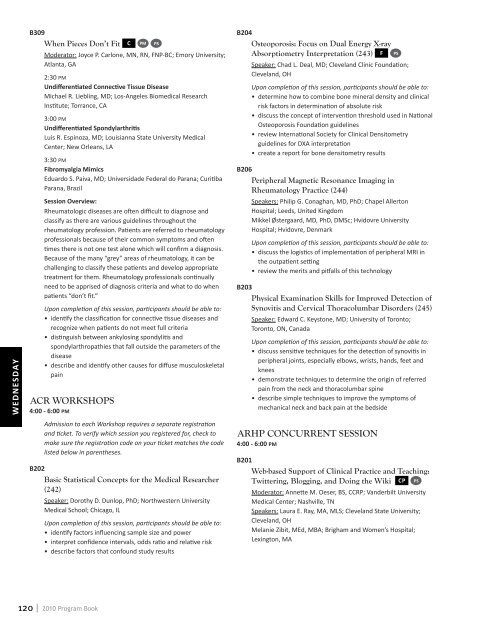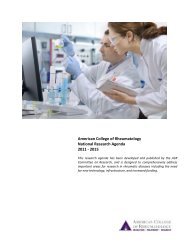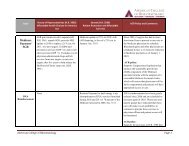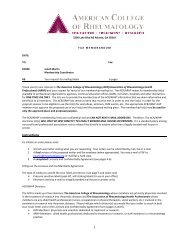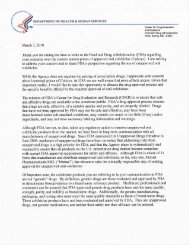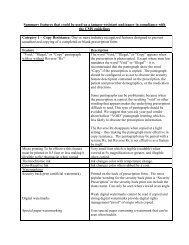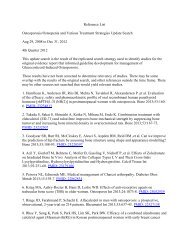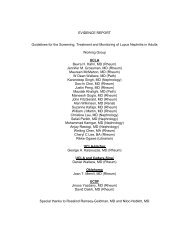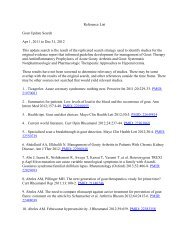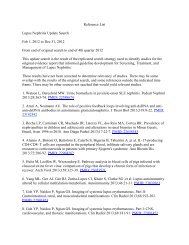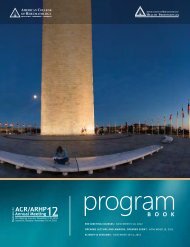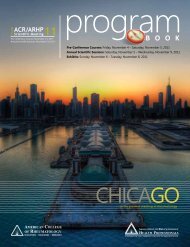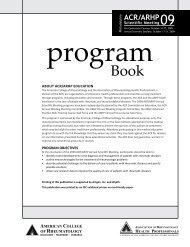B O O K - American College of Rheumatology
B O O K - American College of Rheumatology
B O O K - American College of Rheumatology
You also want an ePaper? Increase the reach of your titles
YUMPU automatically turns print PDFs into web optimized ePapers that Google loves.
wednesday<br />
B309<br />
When Pieces Don’t Fit C<br />
PM PS<br />
Moderator: Joyce P. Carlone, MN, RN, FNP-BC; Emory University;<br />
Atlanta, GA<br />
2:30 PM<br />
Undifferentiated Connective Tissue Disease<br />
Michael R. Liebling, MD; Los-Angeles Biomedical Research<br />
Institute; Torrance, CA<br />
3:00 PM<br />
Undifferentiated Spondylarthritis<br />
Luis R. Espinoza, MD; Louisianna State University Medical<br />
Center; New Orleans, LA<br />
3:30 PM<br />
Fibromyalgia Mimics<br />
Eduardo S. Paiva, MD; Universidade Federal do Parana; Curitiba<br />
Parana, Brazil<br />
Session Overview:<br />
Rheumatologic diseases are <strong>of</strong>ten difficult to diagnose and<br />
classify as there are various guidelines throughout the<br />
rheumatology pr<strong>of</strong>ession. Patients are referred to rheumatology<br />
pr<strong>of</strong>essionals because <strong>of</strong> their common symptoms and <strong>of</strong>ten<br />
times there is not one test alone which will confirm a diagnosis.<br />
Because <strong>of</strong> the many “grey” areas <strong>of</strong> rheumatology, it can be<br />
challenging to classify these patients and develop appropriate<br />
treatment for them. <strong>Rheumatology</strong> pr<strong>of</strong>essionals continually<br />
need to be apprised <strong>of</strong> diagnosis criteria and what to do when<br />
patients “don’t fit.”<br />
Upon completion <strong>of</strong> this session, participants should be able to:<br />
• identify the classification for connective tissue diseases and<br />
recognize when patients do not meet full criteria<br />
• distinguish between ankylosing spondylitis and<br />
spondylarthropathies that fall outside the parameters <strong>of</strong> the<br />
disease<br />
• describe and identify other causes for diffuse musculoskeletal<br />
pain<br />
ACR Workshops<br />
4:00 - 6:00 PM<br />
Admission to each Workshop requires a separate registration<br />
and ticket. To verify which session you registered for, check to<br />
make sure the registration code on your ticket matches the code<br />
listed below in parentheses.<br />
B202<br />
Basic Statistical Concepts for the Medical Researcher<br />
(242)<br />
Speaker: Dorothy D. Dunlop, PhD; Northwestern University<br />
Medical School; Chicago, IL<br />
Upon completion <strong>of</strong> this session, participants should be able to:<br />
• identify factors influencing sample size and power<br />
• interpret confidence intervals, odds ratio and relative risk<br />
• describe factors that confound study results<br />
B204<br />
Osteoporosis: Focus on Dual Energy X-ray<br />
Absorptiometry Interpretation (243) f PS<br />
Speaker: Chad L. Deal, MD; Cleveland Clinic Foundation;<br />
Cleveland, OH<br />
Upon completion <strong>of</strong> this session, participants should be able to:<br />
• determine how to combine bone mineral density and clinical<br />
risk factors in determination <strong>of</strong> absolute risk<br />
• discuss the concept <strong>of</strong> intervention threshold used in National<br />
Osteoporosis Foundation guidelines<br />
• review International Society for Clinical Densitometry<br />
guidelines for DXA interpretation<br />
• create a report for bone densitometry results<br />
B206<br />
Peripheral Magnetic Resonance Imaging in<br />
<strong>Rheumatology</strong> Practice (244)<br />
Speakers: Philip G. Conaghan, MD, PhD; Chapel Allerton<br />
Hospital; Leeds, United Kingdom<br />
Mikkel Østergaard, MD, PhD, DMSc; Hvidovre University<br />
Hospital; Hvidovre, Denmark<br />
Upon completion <strong>of</strong> this session, participants should be able to:<br />
• discuss the logistics <strong>of</strong> implementation <strong>of</strong> peripheral MRI in<br />
the outpatient setting<br />
• review the merits and pitfalls <strong>of</strong> this technology<br />
B203<br />
Physical Examination Skills for Improved Detection <strong>of</strong><br />
Synovitis and Cervical Thoracolumbar Disorders (245)<br />
Speaker: Edward C. Keystone, MD; University <strong>of</strong> Toronto;<br />
Toronto, ON, Canada<br />
Upon completion <strong>of</strong> this session, participants should be able to:<br />
• discuss sensitive techniques for the detection <strong>of</strong> synovitis in<br />
peripheral joints, especially elbows, wrists, hands, feet and<br />
knees<br />
• demonstrate techniques to determine the origin <strong>of</strong> referred<br />
pain from the neck and thoracolumbar spine<br />
• describe simple techniques to improve the symptoms <strong>of</strong><br />
mechanical neck and back pain at the bedside<br />
ARHP Concurrent Session<br />
4:00 - 6:00 PM<br />
B201<br />
Web-based Support <strong>of</strong> Clinical Practice and Teaching:<br />
Twittering, Blogging, and Doing the Wiki cP PS<br />
Moderator: Annette M. Oeser, BS, CCRP; Vanderbilt University<br />
Medical Center; Nashville, TN<br />
Speakers: Laura E. Ray, MA, MLS; Cleveland State University;<br />
Cleveland, OH<br />
Melanie Zibit, MEd, MBA; Brigham and Women’s Hospital;<br />
Lexington, MA<br />
120<br />
2010 Program Book


